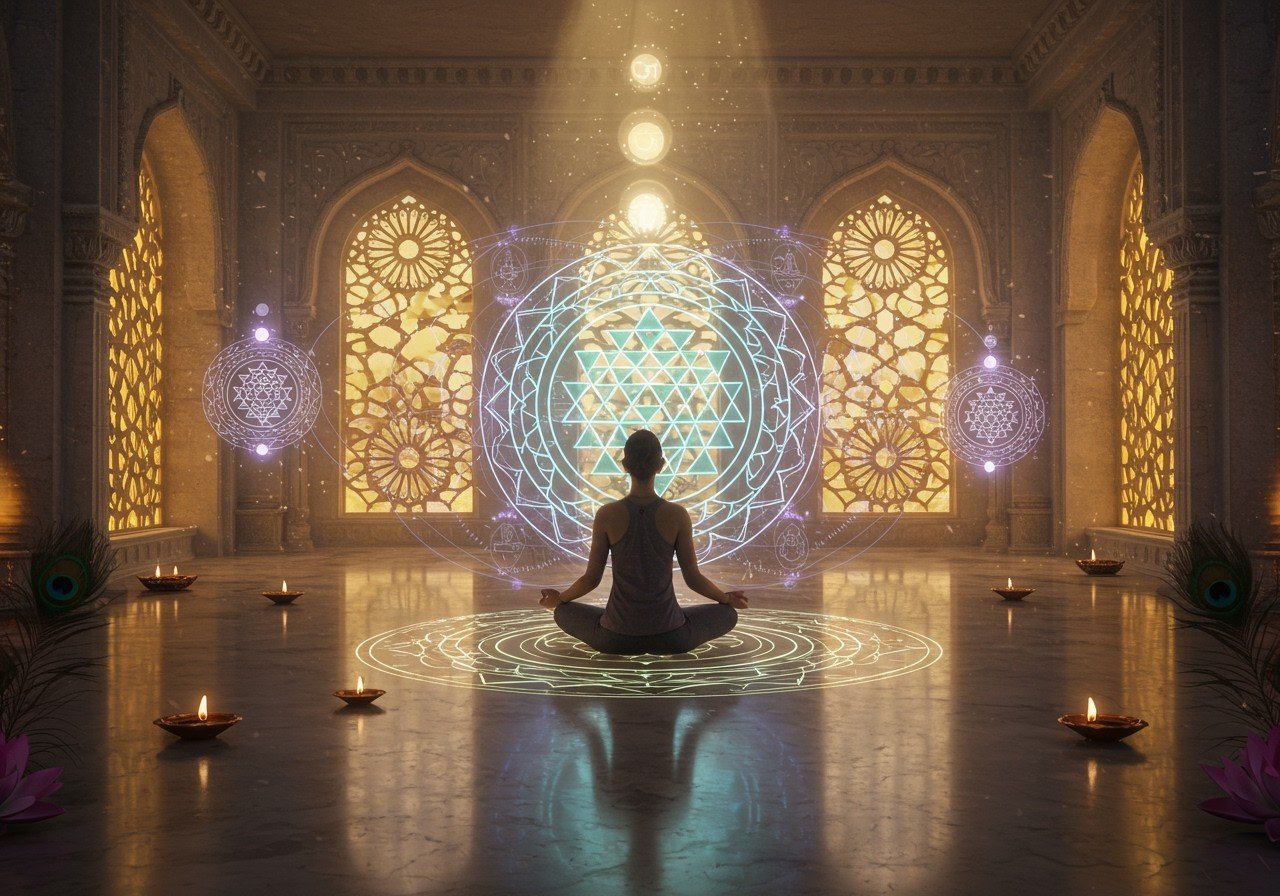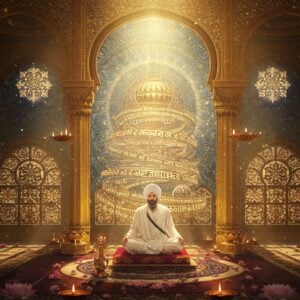
Delving into the profound spiritual practices of Tantra and Mantra unveils their deep connection to Indian culture and heritage. These practices, woven into the fabric of our traditions, offer pathways to spiritual evolution and self-discovery. Tantra, with its intricate rituals, seeks to unite the individual with the divine, while Mantra, a sacred utterance imbued with spiritual potency, serves as a focal point during meditation. As we explore these practices, we’ll discover their enduring relevance in contemporary life, adding depth and meaning to our everyday experiences.
What is Tantra?
Tantra emphasizes the harmonious integration of mind, body, and spirit. At its core lies Shakti, the divine feminine energy that fuels Tantric practices. Ancient texts like the Vijnana Bhairava Tantra illuminate the path through rituals, meditations, and visualizations. The Guru-disciple relationship, a cornerstone of this tradition, ensures the careful transmission of Tantric wisdom across generations.
Tantric practices are often categorized into two distinct paths: the left-hand path and the right-hand path. The left-hand path ventures into unconventional practices, while the right-hand path adheres to more traditional methods. Both paths, however, share a common goal: to unlock the full potential of human consciousness and attain self-realization.
Understanding the Power of Mantras
Mantras hold immense power in spiritual practices due to their inherent vibrational energy. Derived from the Sanskrit word meaning “instrument of thought,” Mantras are more than mere words; they are carriers of spiritual resonance. The vibrations produced during chanting profoundly impact both mind and body. Seed sounds like ‘Om,’ for instance, resonate with a universal frequency.
Mantras like the revered Gayatri Mantra are known for their spiritual benefits. Repetition (Japa) is key to unlocking the potency of a Mantra, fostering mental clarity and inner peace. The rhythmic chanting of Mantras also has a positive influence on our psychological and emotional well-being, promoting a sense of overall balance and harmony.
Distinguishing Between Tantra and Mantra
While interconnected, Tantra and Mantra differ in their objectives and methodologies. Tantra, with its emphasis on rituals, involves both physical and meditative practices. Mantra, primarily vocal, centers on the power of sound. Tantra can be viewed as a broader framework, incorporating Mantras into its rituals and meditations.
While Mantras are generally accessible, Tantra often carries an air of esotericism. Both practices thrive in contemporary spiritual pursuits, though their cultural perceptions may vary.
Exploring the Significance of Yantra
Yantra, a geometric diagram, represents divine energies within Tantric practices. The shapes and patterns within a Yantra hold symbolic meaning, acting as focal points for meditation and concentration. They complement Mantra and Tantra, enhancing the overall spiritual experience. Renowned Yantras like the Sri Yantra are imbued with deep spiritual significance. Consecrating a Yantra involves specific rituals, and these sacred diagrams are believed to infuse positive energy into personal spaces.
At poojn.in, you can find authentic Yantras for your spiritual practices. Explore our collection of Yantras and other Pooja Samagri.
Integrating Spiritual Practices into Daily Life
Weaving Tantra and Mantra into our daily lives can enrich our spiritual journey. Simple Tantric practices like mindfulness can be seamlessly integrated into our routines. Daily Mantra chanting can foster mental clarity and emotional equilibrium. Yantras can enhance the spiritual atmosphere of our homes. When choosing Mantras and Yantras, select those that resonate deeply with your personal beliefs and spiritual aspirations. Intention and dedication amplify the benefits of these practices. Seek guidance from authentic sources and connect with online communities for deeper understanding. By embracing these practices with an open heart and mind, we connect with rich traditions while adapting them to the rhythm of modern life. Tantra and Mantra invite us on a continuous journey of learning and self-discovery.
Start your spiritual journey with authentic products from poojn.in. Browse our Pooja Kits for a convenient way to incorporate these practices into your daily routine.
How Poojn.in Supports Your Tantra and Mantra Practices
Poojn.in simplifies your access to authentic materials for Tantra and Mantra practices. We offer a curated selection of essential items, ensuring quality and adherence to tradition:
For Mantra Practice:
- Mantra Yantra Plates: Crafted from pure copper and brass, these plates enhance the resonance of your chants.
- Rudraksha Malas: Essential for mantra japa, our Rudraksha malas are made with genuine beads.
- Sacred Thread (Kalava): This thread symbolizes protection and is traditionally worn during rituals.
- Mantra Books: Deepen your understanding with our collection of mantra books in Sanskrit and Hindi.
Find all your Mantra essentials at poojn.in’s Pooja Samagri section.
For Tantric Rituals:
- Tantra Samagri Sets: Complete sets containing all the necessary items for specific rituals.
- Copper Vessels and Plates: Pure copper items for use in traditional Tantric practices.
- Ritual Items: Authentic kumkum, roli, and chandan for your rituals.
- Tantric Texts and Guides: Explore the depths of Tantra with our collection of traditional texts.
Explore our range of products specifically designed for Tantric rituals at poojn.in’s Brands section under Poojn.
All items at Poojn.in are carefully vetted for authenticity and blessed according to tradition. We deliver across India, bringing the sanctity of these items to your doorstep. Need guidance? Our experts can assist you in selecting the right items for your practice.
Contact us:
Call: 03369029784
WhatsApp: 9476142738
Visit Poojn.in to discover our complete collection of ritual items and spiritual supplies. We ensure each product meets traditional standards while offering the convenience of online shopping.
Embracing the Journey of Tantra and Mantra
As you delve into the world of Tantra and Mantra, remember that these are not merely rituals; they are profound pathways to self-discovery and spiritual growth. By incorporating these time-honored traditions into your daily life, you honor their deep significance while finding balance and peace in our modern world. Whether it’s through the gentle resonance of a Mantra, the focused stillness of meditating with a Yantra, or the holistic approach of Tantra, each step you take is a step towards a deeper understanding of yourself.
Approach these practices with reverence and commitment, allowing them to guide you on your spiritual journey. Embrace the joy of connecting with ancient wisdom and the harmony it brings to your life. In doing so, you enrich your own experience and keep these cherished traditions vibrant and relevant for generations to come.
Learn more about Mantras and their significance in daily life on our blog: Mantras: Their Power and Purpose in Daily Life.
Expand your knowledge of Hindu deities with our comprehensive guide: Hindu Gods and Goddesses: A Complete Guide.
Frequently Asked Questions
What sets Mantra and Tantra apart? Mantra is a sacred sound, syllable, word, or phrase, often in Sanskrit, repeated to focus the mind and connect with spiritual energy. Tantra encompasses techniques and practices, including mantras, yantras, mudras, and rituals, aimed at accelerating spiritual growth and achieving specific goals.
How do Mantra and Tantra complement each other? Mantras are frequently integral to Tantric practices. Tantra provides the broader framework, while mantra serves as a powerful tool within that framework. They work synergistically to guide the mind towards a desired state, enhancing spiritual development.
What is a Yantra, and how does it relate to Mantra and Tantra? A Yantra is a geometric diagram representing divine energies, often used in Tantric practices as a visual focus for meditation. Like mantras, yantras are tools within the broader Tantric framework, helping to channel energy and focus the mind during spiritual practices. Learn more about Yantras and Yagyas.
Is there any specific eligibility criteria for practicing Tantra and Mantra? No specific religious belief is required to practice Tantra and Mantra. These practices are open to anyone seeking spiritual growth and self-discovery, irrespective of their background. However, guidance from an experienced teacher is always recommended.
Do Mantras hold specific meanings? Yes, Mantras have specific meanings and purposes. They are often in Sanskrit, and each word or phrase carries spiritual significance, aimed at invoking divine energy, focusing the mind, or achieving specific goals. Discover the meanings behind sacred Hindu symbols like Rudraksha and Tulsi: Rudraksha and Tulsi: Sacred Hindu Symbols Explained.
How can incorporating Mantra and Tantra benefit daily life? Regular practice of Mantra and Tantra can bring numerous benefits, including reduced stress, improved concentration, enhanced self-awareness, and a greater sense of inner peace and calm. They can also deepen one’s connection to spirituality and promote personal growth.
Are there any potential downsides to practicing Tantra and Mantra? When practiced correctly and respectfully, with proper guidance, Tantra and Mantra are generally safe. However, misunderstandings or misapplications can arise without proper understanding or guidance. Learning from a knowledgeable teacher or authentic source is always recommended.


